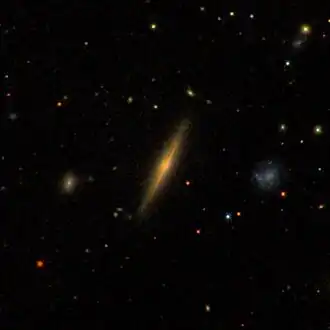NGC 6122
| NGC 6122 | |
|---|---|
 A Sloan Digital Sky Survey (SDSS) image of NGC 6122 | |
| Observation data (J2000 epoch) | |
| Constellation | Corona Borealis |
| Right ascension | 16h 20m 09.40s[1] |
| Declination | +37° 47′ 54.00″[1] |
| Redshift | 0.03347±0.00001[1] |
| Distance | 484 Mly (148.54 Mpc)[1] |
| Apparent magnitude (V) | 14.6[1] |
| Characteristics | |
| Type | Sb[1] |
| Size | 211,000 ly |
| Apparent size (V) | 1.096′ × 0.257′[1] |
| Notable features | N/A |
| Other designations | |
| PGC 57858,[1] LEDA 57858,[1] MCG+06-36-032[1] | |
NGC 6122 is a spiral galaxy located around 484 million light-years away in the constellation Corona Borealis.[2][1] NGC 6122 was discovered on May 6, 1886 by the astronomer Guillaume Bigourdan, and its diameter is 211,000 light-years.[3][4] NGC 6122 is not known to have much star-formation, and does not have an active galactic nucleus.[1][3]
NGC 6122 has been the host of one supernova so far: SN 2003ge.[5] It was discovered on June 21, 2003 by astronomers Tim Puckett and Alex Langoussis. It was located 8".8 west and 0".1 north of the nucleus. The supernova was Type Ia.[6]
References
- ^ a b c d e f g h i j k l "NGC 6122 - Galaxy - SKY-MAP". www.wikisky.org. Retrieved 2024-03-31.
- ^ "NGC 6122 - Spiral Galaxy in Corona Borealis | TheSkyLive.com". theskylive.com. Retrieved 2024-03-31.
- ^ a b "By Name | NASA/IPAC Extragalactic Database". ned.ipac.caltech.edu. Retrieved 2024-03-31.
- ^ "New General Catalog Objects: NGC 6100 - 6149". cseligman.com. Retrieved 2024-03-31.
- ^ "SN 2003ge | Transient Name Server". www.wis-tns.org. Retrieved 2024-04-27.
- ^ "Bright Supernovae - 2003". www.rochesterastronomy.org. Retrieved 2024-04-27.
External links
 Media related to NGC 6122 at Wikimedia Commons
Media related to NGC 6122 at Wikimedia Commons